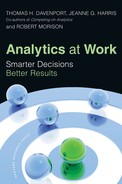Preface
As researchers and writers on business and management, we’ve thrown a fair number of ideas against the wall. We think they’re all great, of course, but it’s always difficult to know in advance whether a particular one will stick.
Somewhat to our surprise, the topic of “competing on analytics” stuck. We tapped into a global secular trend toward more data, more computerized analysis of it, and more orientation to fact-based decision making. Each of these trends had been slowly creeping up over time, and just about the time we started publishing in the area, they exploded. We’d attribute this timing to extreme perspicacity except for the fact that many other trends happened largely without our noticing.
So when Tom wrote an article in the Harvard Business Review called “Competing on Analytics,” and Jeanne and Tom wrote the book by the same name, we immediately saw a lot of demand for speaking and consulting on the subject. In the course of that work we talked with hundreds of managers and analytical professionals in countries all across the globe (except North Korea—we’re sure there are analysts there, but we haven’t met any). Jeanne also worked with Accenture and its clients to mobilize and coordinate that firm’s multiple analytical consulting groups. Tom and Bob led a multicompany research program with nGenera that addressed a variety of topics in the business use of analytics. We decided we should write down what we learned—hence this book.
We all saw a need for more structure around the topic of how to build analytical capabilities. Competing on Analytics was about the earliest and most aggressive adopters of analytics, but many other companies and organizations just wanted to know how analytical they were already, and how to become more so over time. They wanted frameworks, assessment tools, examples, and further insights—so we’ve tried to provide some of each in this book.
This is more of a “how-to” book than its predecessor, but we’ve tried to avoid the extremes of that genre. We do have a five-part model, and because we want readers to be able to remember it, we’ve structured it as a catchy little acronym. We continue with the five-stage model for analytical maturity (God has decreed that all maturity models have five stages) that we introduced in the previous book. However, we’ve resisted saying in exactly what order, or by whom, each step should be taken. There’s no fixed methodology here—just some pragmatic suggestions for how to proceed and some frameworks for measuring your progress. It’s more a compass than a detailed map.
The first part of the book is a little more framework focused than the second. It addresses the five-letter framework (DELTA) that we’ve been talking about and applying to companies over the last couple of years. The first part is also more oriented to current practice. Part two opens things up a bit to address some of the capabilities that analytically oriented organizations will need in the future. Some firms are actually addressing those capabilities today.
